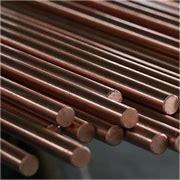1. Introduction
If you’ve got old electronics, wiring, or plumbing lying around, chances are you’re sitting on a stash of valuable copper. But before you can cash in or reuse it, you’ll need to strip the insulation off your copper wire. Whether you’re a DIYer, hobbyist, or small-scale recycler, knowing the best way to strip copper wire is essential—not just for maximizing value, but also for safety and efficiency.

In this guide, we’ll walk you through proven techniques to strip copper wire for scrap quickly and safely. We’ll also clarify the differences between copper types like copper rod, copper strip, and copper bonded ground rods—so you know exactly what you’re working with and how much it’s worth.
2. Why Strip Copper Wire?
Recycling centers pay significantly more for clean, bare copper than insulated wire. For example, ‘bare bright’ copper (clean, uncoated, and untinned) fetches top dollar, while insulated wire may be worth less than half that price.
Beyond profit, stripping copper wire properly helps reduce electronic waste and supports sustainable metal recovery. Plus, if you’re salvaging copper for projects—like making a copper earth rod, copper bus bar, or even copper tape for snails—you’ll need clean, usable material.
3. Tools You’ll Need
- Wire strippers (manual or automatic)
- Utility knife or razor blade (for thicker cables)
- Heat gun (optional, for stubborn insulation)
- Safety gloves and goggles
- Bucket or container for sorted copper
4. Step-by-Step: How to Strip Copper Wire for Scrap
4.1 Identify Your Copper Type
Not all copper is created equal. Common types include:
- Bare copper wire (highest value)
- Insulated electrical wire (needs stripping)
- Copper rod or round bar copper (often used in grounding or welding)
- Copper strip (flat, rolled, or coiled—used in earthing, roofing, or electronics)

Check for markings or color. Pure copper has a distinctive reddish-orange hue. Avoid aluminum or copper-clad steel—these have lower scrap value.
4.2 Choose the Right Stripping Method
For thin wires (<10 AWG): Use manual or automatic wire strippers. These cleanly remove insulation without nicking the copper inside.
For thick cables or armored wire: Score the outer jacket carefully with a utility knife, then peel it back. Avoid cutting too deep—you don’t want to damage the internal copper strands.
For large volumes: Consider investing in a motorized wire stripper or granulator. These machines dramatically speed up stripping wire for recycling.
4.3 Avoid Burning Copper Wire for Scrap
Never burn insulation off! Burning releases toxic fumes (from PVC and other plastics) and oxidizes the copper, lowering its value. Many scrap yards reject burned wire outright—and it’s illegal in some areas.
4.4 Sort and Clean Your Copper
After stripping, separate your copper into categories:
- Bare bright copper wire
- #1 copper (clean pipe, bus bars, or rod copper)
- #2 copper (tarnished, painted, or slightly dirty)

Wipe down pieces with a dry cloth. Avoid using water or chemicals unless absolutely necessary—moisture can cause oxidation.
5. Bonus Tips for Maximizing Value
5.1 Know What’s Worth More
Copper rod price and copper strip price vary based on purity and form. For instance, a copper earth strip 25x3mm or 1mm copper strip may sell at premium rates if clean and unalloyed. Beryllium copper strip or nickel plated copper strip often has specialized industrial value.
Copper bonded earthing rods and copper clad steel ground rods contain less pure copper—they’re not ideal for scrap unless specified by your recycler.
5.2 Where to Sell or Reuse
Search for ‘copper strip near me’ or ‘copper bars for sale’ to locate local scrap yards or metal suppliers. Some accept copper round bar, flexible copper bus bar, or even copper ingot for resale.
If you’re repurposing, consider using stripped copper for DIY projects like copper roof strip, copper edging strip, or crafting your own copper brazing rod for repairs.
6. Common Mistakes to Avoid
- Using pliers or teeth to strip wire (damages copper and risks injury)
- Mixing copper alloys (like brass or bronze) with pure copper
- Ignoring local regulations on metal recycling
- Overlooking hidden copper sources (e.g., aircon copper pipe, copper tubing fittings, or copper pipe connectors from old AC units)
7. Conclusion
Stripping copper wire for scrap doesn’t have to be tedious or dangerous. With the right tools and techniques, you can efficiently recover high-value copper—from thin copper strips to thick copper rod—while staying safe and eco-conscious. Remember: the best way to strip copper wire is cleanly, carefully, and without burning. Whether you’re after copper rod price updates, sourcing a roll of copper strip, or salvaging air conditioner copper pipe, clean, bare copper always wins.
Our Website founded on October 17, 2012, is a high-tech enterprise committed to the research and development, production, processing, sales and technical services of ceramic relative materials such as How. Our products includes but not limited to Boron Carbide Ceramic Products, Boron Nitride Ceramic Products, Silicon Carbide Ceramic Products, Silicon Nitride Ceramic Products, Zirconium Dioxide Ceramic Products, etc. If you are interested, please feel free to contact us.

